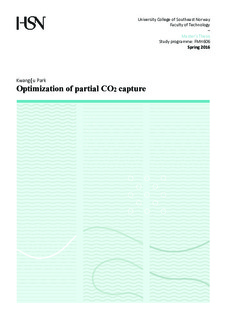| dc.description.abstract | The cement industry accounts for about 5 % of the global anthropogenic CO₂ emissions. Traditional post-combustion CO₂ capture with monoethanolamine absorption is highly energy-intensive, which in turn leads to expensive capture cost. To optimize the capture cost in a cement plant, this study focused on optimizing the postcombustion CO₂ capture process with Aspen HYSYS using waste heat only. Impact analysis was carried out based on the three process parameters: flue gas inflow ratio into the absorber, number of stages in the absorber column and the superficial gas velocity.
Despite the high investment, routing all of the flue gas into the absorber was calculated to be the most effective alternative in terms of capture cost because it gave the highest CO₂-capture rate. The capture rate showed little decrease even with fewer absorber stages. With the assumption that 1 m/packing is equivalent to a Murphree efficiency of 0,15, the number of absorber stages giving the minimum capture cost was five. On the other hand, routing only part of the flue gas into the absorber column consistently resulted in lower capture rate. There were also limitations in reducing the absorber column stages to five, largely due to a sharp decrease in CO₂-capture rate with fewer column stages. The effect of the gas velocity on capture cost was also studied. For Mellapak 250Y and 250X, the optimal gas velocity was found to be as low as 1,5 m/s mainly due to reduced pressure drops. In the case of Mellapak 2X, the minimum capture cost was obtained with the gas velocity of 2,0 m/s.
Of the three structured packings, Mellapak 2X yielded the minimum capture cost, with the value being 85 NOK/tonne CO₂. For Mellapak 250Y and 250X, they both showed the minimum capture cost of 86 NOK/tonne CO₂. The capture cost differences between these packings are not significant to determine the most cost-effective packing. | nb_NO |
